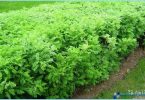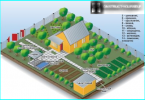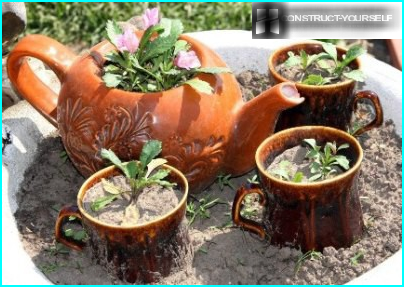
In March still hear the echoes of the February blizzards, and caring gardeners have already rushed to their suburban areas, to put them in order for the upcoming season. It would seem that you can do in the garden in early spring, when the earth was not yet warmed up and in the ditches and all snow? In fact, the spring working in the country include a wide range of activities on territory cleaning, care of the trees, preparing the soil for planting.
The contents
Cleaning of garden after winter
It is first necessary to remove from the garden all served as protection from winter frosts. Covering material or special design needs to be cleaned, rinsed, dried and put away in the storeroom until the autumn frosts. With raised beds, flower beds and garden areas should be removed with the remaining fall debris: fallen trees, old branches, fallen leaves, withered grass. Even if cleaning takes place in the fall, to spring again accumulate a bit of garbage.
It is possible that with the first rays of sun hatch and enemies of cultivated plants to weeds. While the roots are weak, the germs can easily be removed from wet soil. Warmth begins to grow moss in damp places, algae. Short growth is easily removed with a stiff brush, and the track of natural stone or brick with the first foci of a young moss can be washed with a strong jet of water from a garden hose. Any event with water should be carried out at zero temperature, otherwise the country yard turns into a skating rink.
Containers, vases and flower pots also need to clean, restore their integrity, if there were cracks, and treating with herbicides. From the tanks, which served as a place of wintering of perennial flowers, you should get the old soil and replace it with fresh, and tubers and rhizomes of plants — dry thoroughly.
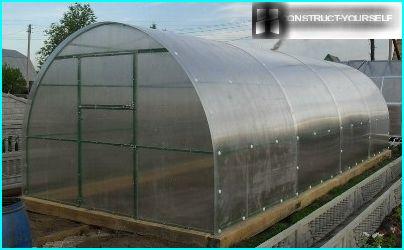
Early spring is a good time to repair polycarbonate greenhouses, which could suffer in the winter from snow drifts
Mulching and fertilizing the soil
Mulching is carried out in the flower beds in the garden and in the garden. A thick layer of mulch for the plants creates comfortable conditions, warming their roots in the cold and protecting from the scorching rays of the sun in the heat. It perfectly retains moisture, eliminates weeds and protects against dangerous insects. Many cultivated plants (strawberries, cucumbers, zucchini, pumpkin) less susceptible to rot and increase yields by mollirovannogo ground. We should not forget about the decorative effect: melirovannye soil looks well-groomed and neat.
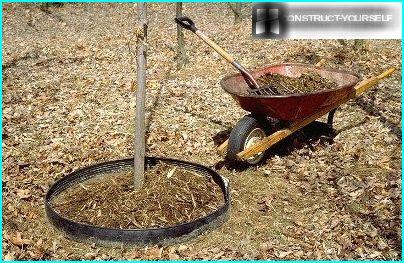
When mulch (e.g., bark or sawdust) is added to the biological fertilizer – manure, be sure to check the degree of perepilet. Not until the end of the oxidized substance can destroy plants
The material for the manufacture of mulch:
- sawdust;
- compost;
- bark;
- chips;
- straw;
- rotted leaves;
- ukrywa fabric.
In March or April spend feeding the soil, even if it is considered rich and wealthy. Fertilized soil ensures rapid growth and high decorative qualities of flowers and herbs, a rich harvest of vegetable crops and fruit trees. Especially appreciated are potassium, phosphorus and nitrogen which are part of a comprehensive universal fertilizer «NPK», «Azofoska». Fine granules are mixed with water or just dumped on the beds with melting snow severely restricted in the proportions specified on the package. Read more in the article «Than to fertilize spring vegetable garden: tips on choosing quality fertilizers».
Care of fruit trees
Simple garden work to care for shrubs and trees, rejuvenate them, increase the yield and improve the appearance of plants.
Pruning branches and shoots
When the temperature reached 0°C, was positive, but is still low, you should produce a crop of stone fruit trees and berry bushes. As a result of pruning the crown of a tree should take a bowl with an open centre, which provides perfect lighting to each branch and great access of air. Crown thinning and shortening branches relevant in a time when the trees have no flowers, leaves and even swollen kidney. Along with the shoots are pruned and the trunk.
The planting of fruit seedlings
With the first rays of the sun, immediately after descent of snow, should be planted young seedlings. Planting should be done while the trees are dormant, sleep, that is do not have kidney, otherwise the seedlings will die without having lived a couple of weeks.
Planting young fruit trees occurs in the following order:
- Pull a shallow pit at the bottom of which is placed the manure and above it a thin layer of enriched soil.
- The roots of the seedling is placed into the prepared hole, carefully added dropwise and slightly compacted the soil with their feet.
- Drive next to the sapling stake which is for him the first time.
- Watered and watched, the ground around the roots does not dry up.
See the video:
Grafting to obtain new varieties
Spring – the best time for grafting trees. With the same success it is possible to carry out budding (inoculation kidney) or topolyovka (vaccinated with the handle). Stick shoots are the most viable, since shoots from grafted buds barely survive the winter. The most successful time for Cherenkova vaccinations is between mid-April and early June. The operation is performed grafting knife or secateurs. One of the main conditions of effectiveness – close contact of the rootstock and Scion.
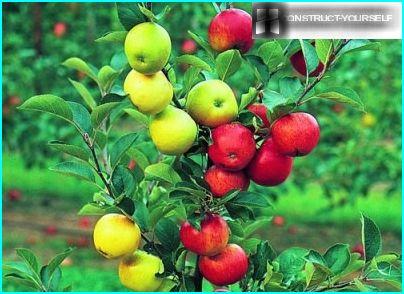
Spring grafting fruit trees is a great opportunity to have a summer cottage on the many varieties, having landed thus only a few major trees
Read more about immunizations trees can be found in the article: «Grafting fruit trees: a comparative review of the best ways to cross trees».
Treatment of beds with perennials
The division of herbaceous perennials would be more effective if performed early in the spring. Thanks to him, increases the resource of planting material and updated the old plants that are starting to lose color, wilt and rot. If the time to divide the rhizomes of bells, asters, Phlox, crocosmia, they will increasingly grow, and flowering will be longer and more violent. Large bushes are divided into four parts the usual bayonet with a shovel, putting them on the Board. The place of the incision are the gaps between the kidneys. The roots of small plants share the garden with a knife.

Bright crocosmia after the upgrade procedure, be given a second life: they should dig up every 2-3 years, to separate babies and transplant to another location
The renewal of spring lawn
Silky grass of the lawn is pleasing to the eye throughout the entire summer, since early spring it is necessary to conduct a range of activities, the main ones are:
- fertilizing;
- combing;
- aeration;
- weeding.
Sowing and rolling lawns equally well respond to early nitrogen fertilizers, which must be paid immediately after the descent of the snow. Nitrogen in combination with phosphorus and potassium gives grass growing, so fertilizing can be hold until the first shoots emerge. One of the suitable fertilizers «Quimera».
The next step is aeration and combing. During the winter has accumulated a lot of garbage and vegetable felt, which interferes with growth and light. The most suitable tool for combing the lawn – electric articulator, carefully collecting felt. To dense soil did not become an obstacle for the air necessary to the roots, use an aerator or an ordinary fork, methodically piercing of the soil. Towards the end of the spring should be weeding. With a small amount of weed a fairly manual method, otherwise use chemical weeding with herbicides.
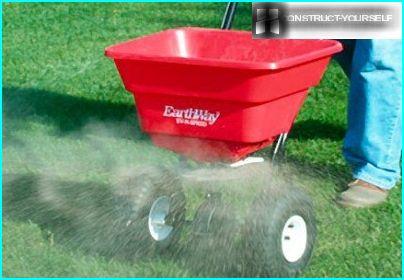
For a uniform and metered fertilizer to the lawn, there are many adaptations, one of which is a handy trolley with two wheels
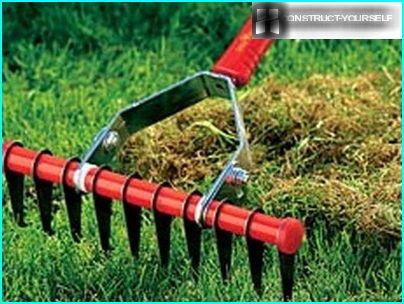
If the lawn is small, then the procedure of combing, you can use an ordinary garden rake and aeration forks
Methods of planting vegetables
If your climate is, many vegetables are planted directly in the open ground. There are several ways of landing, which depend on the location:
- in the trench;
- on elevated ridges;
- on embankments;
- out of the blue ridges;
- in containers.
If the soil is light, sandy, warms up quickly, but poorly retains moisture, better to use the trench method. Clay soils also are easily heated to the same perfectly retain moisture, so they are traditionally used raised ridge. Several layers of manure, soil and compost, laid on a special scheme, form the bulk of the ridge, which is called «smart garden». Ordinary smooth ridge use in greenhouses and containers where planting is not enough free space.
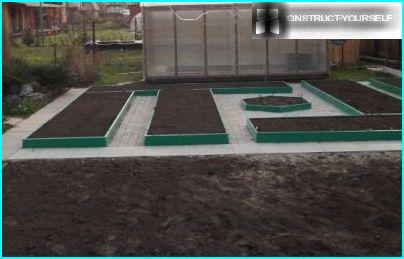
Raised ridges are used for planting vegetables and flowers. Their distinctive feature — a border made of wooden boards or ceramic tiles
Pest control
Unfortunately, with the onset of heat aktiviziruyutsya harmful insects that can negate all the efforts of the hardworking gardeners. Many of them attacking fruit trees and shrubs. You need to carefully inspect all the branches and to pay attention to bonded dry leaves. Perhaps it nests euproctis chrysorrhoea or boyaryshnitsy. They must be picked by hand, and burn.
Beetles weevils destroy cold days, when they freeze and stop moving. Under the tree lay wrap, then shake the branches. Fallen insects burn. From the moths and leaf rollers, apply tincture of mustard or wood ash. Sucker scared the infusion of garlic with tobacco.
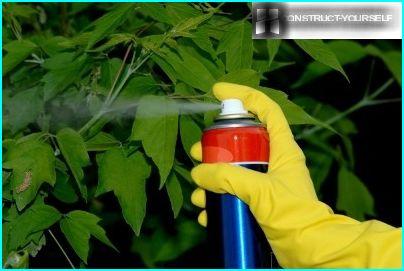
For spraying trees against pests also use a solution of copper sulfate, urea, Bordeaux mixture, iron sulphate and aphids helps soap
In addition to these kinds of spring work, there are many others, such as planting flower crops, upgrading of garden furniture, cleaning of water bodies.

